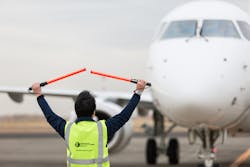Safety culture is an important key to successful safety performance in the aircraft ground handling environment. The East Asia region has distinctive cultural peculiarities that require specific organization safety culture promotion initiatives.
According to KH Kwak, Swissport Korea’s head of quality, health, safety and environment (QHSE) and training, there are some cultural traits that may increase the fear of repercussion throughout the ground handling industry in the Far East and other parts of Asia. These cultural features include respect for the rules, team and group culture, respect for superiors and the concept of “keeping face.”
“Asians may not actively express their thoughts or opinions compared to people of other continents. This phenomenon can be seen as a result of rigid up-and-down relationships among employees. However, many Asian countries have tried to solve these problems not only in the ground handling industry but also in various other fields,” says Jaeseong Lim, CEO of UBjet Aviation. “Also, Asian VIPs usually set great store by formality and escort service. Conversely, CIQ [China Inspection and Quarantine] officers are not cooperative to businesspeople. They are reluctant to provide a private jet's passengers with special convenience, based on the idea that it's unfair to give privileges to some people, even to corporate executives, as they are same with passengers who take a commercial flight. So, providing a seamless service for the passengers is difficult sometimes.”
There are several factors that can influence and increase the fear of repercussions in the ground handling environment.
“The Far East or Asian culture may have a big impact, but the significant impact of fear is the culture of the organization,” says James Nainggolan, regional safety manager of the Asia-Pacific (APAC) Region at Universal Weather and Aviation. “When discussing the culture of the organization, the term ‘nonpunitive’ must be seen throughout the organization. This means the top to bottom must breathe and support it. It will not be an effective safety or operational program if the leadership does not practice the nonpunitive/safety culture.
“Moreover, if the top management who are influenced by the local culture does not support the safety culture and runs the organization based on local culture, it will confuse the organization,” he continues. “And, when confused, more often than not, the organization will revert to what is familiar and that is the local culture.”
Asia is composed of several countries with vast territories and diverse cultures and languages, so an over-generalization would be inappropriate.
“The diversity of such cultures and languages plays a very important role in breaking down prejudices between each other in safety. This unbiased safety can lead to accurate information and shortening the time required for safety,” says Lim.
Kwak believes there are generally several aspects of the national and organizational cultures that have a positive influence on safety in the Far East and Asia. These include a tendency towards being hardworking, reliable, conscientious and diligent. There is also generally a tendency to follow the rules, maintain a team and group culture, have respect for superiors and value education.
“All aspects of the national culture can have positive influence on safety. It is how the organization builds on the national culture that will determine how successful the national and organizational culture can be a positive influence on safety. Of course, it will not work if the whole of the organization does not talk the talk and walk the walk,” says Nainggolan.
There are currently several initiatives being implemented by the aircraft ground handling service providers in Asia to support a positive safety culture and they cover specific aspects.
“Actively listening to employees is one of the initiatives we have implemented and which we firmly believe strongly supports a positive safety culture in Swissport Korea. This approach has enabled us to gain a better understanding of the risks confronting front-line staff and encouraged staff to become more actively involved in maintaining a safe work environment,” says Kwak. “Unsafe conditions and behaviors are reported by employees openly every month and active suggestions on safety are encouraged in various meetings.
“This active and open communication is the first step to make everyone become voluntary safety leaders.”
In addition to listening closely to the safety concerns and advice from staff, Swissport Korea is committed to fostering an effective communication culture where all safety information flows smoothly between management and staff. This ensures everyone is fully cognizant of the “safety first” message.
“Another effective safety initiative within Swissport Korea is a program of regular local ‘Safety Patrols’ which are performed by various staff members together as a team,” Kwak points out.
The implementation of safety management system (SMS) is a great spark that provides a positive influence on the safety culture of the Far East and Asia, according to Nainggolan.
“Ground handling has been an industry that was overlooked and perceived as having a less risky role in the business jet ground handling industry. If one takes stock of the civil aviation organizations around the world, almost all do not have any regulatory mechanism for business jet ground handling operations. This is changing with the growth of the industry and the adoption of safety programs with SMS in tow,” he says. “With the integration of SMS into the business, it also helps the organizations to implement organized systems to make sure that standards and operational quality are held and, at the same time, to implement improvements for the industry.”
Indeed, there are significant benefits of positive safety culture implementation in ground handling.
“By achieving high safety standards, we can ensure our staff go home safely at the end of every shift and our customers can rest assured that they are in safe hands. A safe environment ensures Swissport Korea is equipped to overcome future challenges and grow without undue risk,” says Kwak. “To maintain high safety standards Swissport Korea is continuously on the lookout for innovative advances in technology, ground service equipment and work processes to take the risks out of ground handling.”
In recent times, ground handling companies have received more recognition as a key player in the aviation industry especially in terms of airside safety.
“Ground handling companies are becoming increasingly involved in and initiating various activities not only for safe aircraft handling but also general airside safety. Swissport Korea is also actively participating and contributing in various ways together with other parties to improve airside safety and safe aircraft handling,” says Kwak.
Benefits of positive safety culture implementation are personal growth, organizational growth and outside-the-box thinking.
“Implementation of safety culture encourages persons and organizations to look outside for solutions,” concludes Nainggolan. “This looking outside also helps the industry share their ‘war stories’ and help each other improve operations.”






